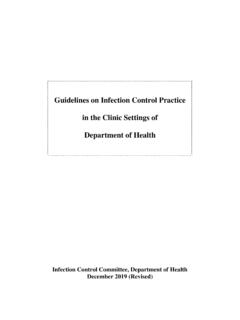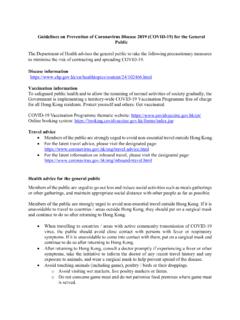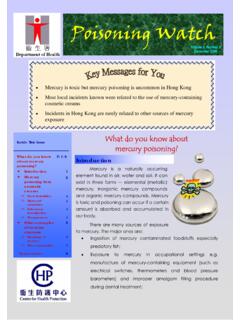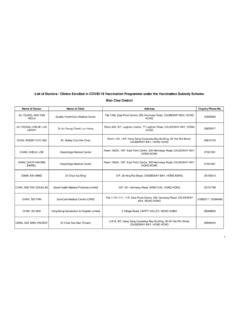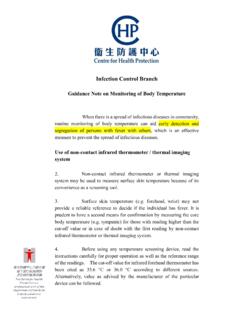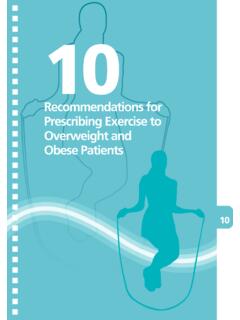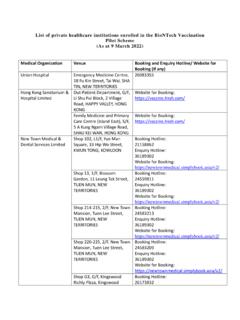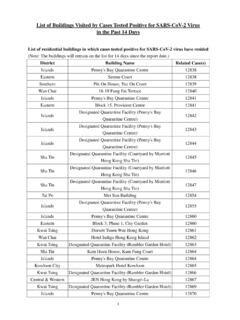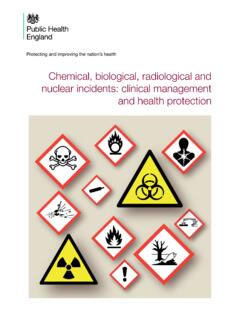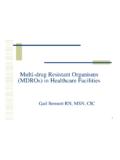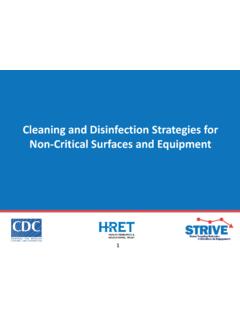Transcription of Precautions for Handling and Disposal of Dead Bodies (The ...
1 Precautions for Handling and Disposal of Dead Bodies Department of Health Hospital Authority Food and Environmental Hygiene Department The 10th edition, 2014 (Last reviewed: June 2022) Page 2 of 24 If you have any comment or enquiry, please kindly contact the Secretary of the Editorial Board for Precautions for Handling and Disposal of Dead Bodies . Correspondence Address: Infection Control Branch, G/F Centre for Health Protection, 147C, Argyle Street, Kowloon. 1st edition Dec 1994 2nd edition May 1997 3rd edition Nov 1999 4th edition Jan 2002 5th edition Oct 2005 6th edition Jun 2008 7th edition Apr 2009 8th edition May 2010 9th edition Jan 2013 10th edition Sep 2014 (Last reviewed: June 2022) Page 3 of 24 Table of contents Introduction .. 4 Categorization of Dead Body .. 4 General Recommendations for All Related Persons .. 6 A. Vaccination .. 6 B. Personal hygienic measures and protective equipment.
2 6 C. Accidental exposure to blood or body fluids .. 6 D. Clinical waste management .. 7 E. Environmental control .. 7 Precautions for Specific Groups .. 8 F. Health Care Worker .. 8 G. Mortuary staff .. 10 H. Funeral workers .. 12 I. Staff Handling dead Bodies of unknown category .. 14 Appendix I: Samples of Dead body Category Tags .. 16 Appendix II: Summary table on precautionary measures for Handling and Disposal of dead Bodies .. 17 Appendix III: Recommended Precautions for relatives when Handling dead Bodies under Category 1, Category 2 & Category 3 .. 18 Recommended Precautions for relatives when Handling dead Bodies under Category 1 .. 19 Recommended Precautions for relatives when Handling dead Bodies under Category 2 .. 20 Recommended Precautions for relatives when Handling dead Bodies under Category 3 .. 21 Page 4 of 24 Introduction All dead Bodies are potentially infectious and STANDARD Precautions should be implemented for every case.
3 Although most organisms in the dead body are unlikely to infect healthy persons, some infectious agents may be transmitted when persons are in contact with blood, body fluids or tissues of dead body of person with infectious diseases. To minimize the risks of transmission of known and also unsuspected infectious diseases, dead Bodies should be handled in such a way that workers exposure to blood, body fluids and tissues is reduced. A rational approach should include staff training and education, safe working environment, appropriate safe work practices, the use of recommended safety devices and vaccination against hepatitis B. There is a need to maintain the confidentiality of a patient s medical history even after his/her death. At the same time, there is obligation to inform personnel who may be at risk of infection through contact with dead Bodies so that appropriate measures may be taken to guard against infection.
4 The discrete use of labels such as Danger of infection on the dead body is considered appropriate. The objectives of drawing up this set of guidelines are: (1) to enable the deceased s family to obtain funeral services, and (2) to protect the involved personnel, workers and relatives. Hospitals, public mortuaries, funeral workers and staff on board conveyances are urged to adopt them in light of local circumstances and requirements. The adopted Precautions should be widely disseminated to all staff involved. For Handling of Dead Bodies of suspected/confirmed Ebola Virus Disease (EVD): Please refer to the Supplementary Guidance for Handling of Dead Bodies of suspected/confirmed Ebola Virus Disease (EVD) Page 5 of 24 Categorization of Dead Body Based on the mode of transmission and the risk of infection of different diseases, the following categories of Precautions for Handling and Disposal of dead Bodies are advised: Cat.
5 1 Signified by a BLUE label (Sample attached in Appendix I) Standard Precautions are recommended for all dead Bodies other than those with infectious diseases as listed under Categories 2 & 3. Cat. 2 Signified by a YELLOW label (Sample attached in Appendix I) In addition to standard Precautions , additional Precautions are recommended for dead Bodies with known: (a) Human Immunodeficiency Virus infection (HIV) (b) Hepatitis C (c) Creutzfeldt-Jacob disease (CJD) without necropsy (d) Severe Acute Respiratory Syndrome (SARS) (e) Avian influenza (f) Middle East Respiratory Syndrome (MERS) (g) Novel Coronavirus Infection (h) Monkeypox, and (i) Other infectious diseases as advised by the physician i/c, the infection control officer or microbiologist. Cat. 3 Signified by a RED label (Sample attached in Appendix I) In addition to standard Precautions , stringent Precautions are recommended for dead Bodies with known: (a) Anthrax (b) Plague (c) Rabies (d) Viral haemorrhagic fevers (e) Creutzfeldt-Jacob disease (CJD) with necropsy, and (f) Other infectious diseases as advised by the physician i/c, the infection control officer or microbiologist.
6 Please refer to the summary table at Appendix II for the specific precautionary measures required under respective category. Page 6 of 24 General Recommendations for All Related Persons A. Vaccination Hepatitis B vaccination is recommended for all personnel who are likely to come into contact with dead Bodies , such as health care worker, mortuary staff, funeral workers, and etc. B. Personal hygienic measures and protective equipment 1) All staff should be trained in the prevention of infections. A high standard of personal hygiene should be adopted. 2) When Handling of dead Bodies : (a) Avoid direct contact with blood or body fluids from the dead body. (b) Put on personal protective equipment (PPE) including Category 1: Gloves, water repellent gown and surgical mask. Use goggles or face shield to protect eyes, if there may be splashes. Category 2: Gloves, water resistant gown/ plastic apron over water repellent gown, and surgical mask.
7 Use goggles or face shield to protect eyes, if there may be splashes. Category 3: Water resistant gown, surgical mask, eye protection (goggles or face shield), double gloves, shoe covers / boots. (c) Make sure any wounds, cuts and abrasions, are covered with waterproof bandages or dressings. (d) Do NOT smoke, drink or eat. Do NOT touch your eyes, mouth or nose. (e) Observe strict personal hygiene. Hand hygiene could be achieved by washing hands with liquid soap and water or proper use of alcohol-based hand rub. (f) Avoid sharps injury, both in the course of examination of dead body and afterwards in dealing with waste Disposal and decontamination . 3) Remove personal protective equipment after Handling of the dead body. Then, wash hands with liquid soap and water immediately. C. Accidental exposure to blood or body fluids 1) In case of percutaneous injury or mucocutaneous exposure to blood or body fluids of the dead body, the injured or exposed areas should be washed with Page 7 of 24 copious amount of water.
8 2) All incidents of percutaneous or mucocutaneous exposure should be reported to the supervisor. The injured person should immediately seek medical advice for proper wound care and post-exposure management. D. Clinical waste management 1) The definition of clinical waste and its management has been set out in the Waste Disposal Ordinance (Hong Kong Law ). For details, please refer to the website of the Environmental Protection Department. ( ) 2) Items classified as clinical waste must be handled and disposed of properly according to the legal requirements. E. Environmental control 1) All surfaces which may be contaminated should be wiped with 1 in 49 diluted household bleach * (mixing 1 part of bleach with 49 parts of water), leave it for 15-30 minutes, and then rinse with water. Metal surfaces could be wiped with 70% alcohol. 2) Surfaces visibly contaminated with blood and body fluids should be wiped with 1 in 4 diluted household bleach *(mixing 1 part of bleach with 4 parts of water), leave it for 10 minutes, and then rinse with water.
9 * Bleach solution should be freshly diluted. Page 8 of 24 Precautions for Specific Groups F. Health Care Worker Last offices The dead body is classified by the attending physician as category 1, 2 or 3. Tags for classification of categories of dead Bodies should be attached to the dead body and the body bag or mortuary sheet. Staff should put on appropriate personal protective equipment before Handling the dead body. Category 1: Gloves, water repellent gown and surgical mask. Use goggles or face shield to protect eyes, if there may be splashes. Category 2: Gloves, water resistant gown/ plastic apron over water repellent gown, and surgical mask. Use goggles or face shield to protect eyes, if there may be splashes. Category 3: cap/hood, face shield/goggles, N95 respirator, water resistant gown, long nitrile gloves/double nitrile gloves, full length shoe covers/ boots.
10 All tubes, drains and catheters on the dead body should be removed. Extreme caution should be exercised when removing intravenous catheters and other sharp devices. They should be directly disposed into a sharps container. Wound drainage and needle puncture holes should be disinfected and dressed with impermeable material. Secretions in oral and nasal orifices can be cleared by gentle suction if needed. Oral, nasal and rectal orifices of the dead body have to be plugged to prevent leakage of body fluids. The body should be cleaned and dried. Dead Bodies under Category 1: The dead body can be either wrapped with a mortuary sheet or placed in an opaque body bag. Dead Bodies under Category 2 or Category 3 : (a) The dead body should be first placed in a robust and leak-proof Page 9 of 24 transparent plastic bag of not less than 150 m thick, which should be zippered closed.
